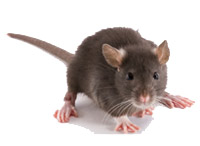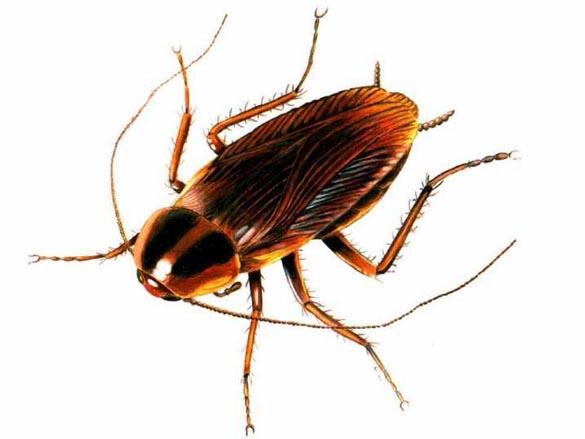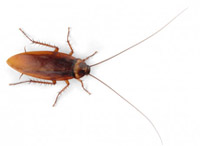Pest Library
"THE ENEMY WITHIN"
Roaches, the most common insect known to the urban dweller, can categorically cause all of the following problems:
- Transmit Disease
- Infest Food
- Infest Paper Goods
- Cause Loss of Business
- Cause Electrical Malfunctions
- Attract Larger Pests
RODENTS:Each year the cost of combating rodents continues to rise. In our rural areas crop damage caused by field rodents has a dramatic effect on the price we pay for our food. In our urban areas a constant, costly battle is ensued daily to combat against rodents.
In all areas, the threat to the health of the population is evident by the increasing number of reported rat bites. Food contamination and its effects are the number one concern of all eating establishments.
RATS: Rats can cause a great deal of costly damage. Both roof rats and Norway rats have a remarkable ability to adapt to nearly every environment.  Rats have an acute ability to notice differences in their surroundings creating a degree of difficulty in controlling an infestation. Rats have also been known to be carriers of disease.
Rats have an acute ability to notice differences in their surroundings creating a degree of difficulty in controlling an infestation. Rats have also been known to be carriers of disease.
MICE: The average house mouse usually travels no more than 10-20 feet from its nest. Mice can reproduce over 200 offspring, within a 4-month p eriod. Mouse droppings and urine can cause food contamination. Because mice will eat up to 20 times a day, it is not unlikely to see activity many times throughout the day.
eriod. Mouse droppings and urine can cause food contamination. Because mice will eat up to 20 times a day, it is not unlikely to see activity many times throughout the day.
ANTS: Ants as a group feed upon almost everything consumed by humans. They will also nest in an d around homes and business causing a nuisance as well as an unsanitary condition. Carpenter Ants, in particular can cause a great deal of wood damage, by entering homes and nesting in wood beams and rafters.
d around homes and business causing a nuisance as well as an unsanitary condition. Carpenter Ants, in particular can cause a great deal of wood damage, by entering homes and nesting in wood beams and rafters.
GERMAN ROACH: Biology: German cockroaches are the most common household insect found in the United States. This pest is usually found infesting the kitchen or bathroom, but has the capability of living in any portion of any heated structure. They are usually found in dark, secluded harborage areas such as under cupboards, behind cabinets, in wall voids, or around motor housings in appliances. Ge rman cockroaches are nighttime insects. They remain hidden in dark, secluded harborage areas in the day. If they are seen during daylight, it is a sure sign that tremendous population exists.
rman cockroaches are nighttime insects. They remain hidden in dark, secluded harborage areas in the day. If they are seen during daylight, it is a sure sign that tremendous population exists.
AMERICAN ROACH: Biology: American cockroaches are not common in most homes. They are abundant in s ewers and are often found in large numbers in groceries, prisons, restaurants, hospitals, office buildings, and apartment buildings. These pests like to inhabit warm, damp locations and are often found in steam tunnels and boiler rooms. They are good flyers and can migrate from building to building on the wing.
ewers and are often found in large numbers in groceries, prisons, restaurants, hospitals, office buildings, and apartment buildings. These pests like to inhabit warm, damp locations and are often found in steam tunnels and boiler rooms. They are good flyers and can migrate from building to building on the wing.
HOUSE FLIES: The housefly is gray to brownish in color and is the most common of domestic flies. The female fly can lay up to 500 eggs in a three to four day period.  Eggs are commonly laid in rotting garbage, organic matter, etc. Their life cycle can complete itself in as little as 3-5 days with adult flies living on average life for up to 2 months. House Flies grow in warm, moist environments. Corrective house fly control techniques involve the use of proper sanitation measures to prevent attracting adult flies, which in turn results in egg laying.
Eggs are commonly laid in rotting garbage, organic matter, etc. Their life cycle can complete itself in as little as 3-5 days with adult flies living on average life for up to 2 months. House Flies grow in warm, moist environments. Corrective house fly control techniques involve the use of proper sanitation measures to prevent attracting adult flies, which in turn results in egg laying.
FRUIT FLIES: Fruit flies are small, red-eyed, 1/4 inch long flies commonly associated with overripe and fermenting fruits and vegetables. The common  misconception is fruit need not be present to have fruit flies, as they can originate from other sources. Fruit flies can reproduce anywhere there is fermenting organic matter such as liquid or solid matter that stays consistently wet or moist. Like other flies, the fruit flies develop from larvae, and fruit fly larvae must have moist, fermenting
misconception is fruit need not be present to have fruit flies, as they can originate from other sources. Fruit flies can reproduce anywhere there is fermenting organic matter such as liquid or solid matter that stays consistently wet or moist. Like other flies, the fruit flies develop from larvae, and fruit fly larvae must have moist, fermenting
organic matter in order to survive. Fruit flies are best controlled by locating and eliminating the source of the infestation.
DRAIN FLIES: Drain flies are small, dark, fuzzy, moth-like insects and are more active at night. They are often found clinging to the walls of bathrooms, kitchens, or in the basements or hovering over drains, sinks and other breeding areas. Drain flies breed in polluted shallow water or the scum that often collects in and around drains. The most effective control method is to clean the drain pipes with a stiff brush, removing all the build-up in which the flies breed; flushing the drain with hot water
or the scum that often collects in and around drains. The most effective control method is to clean the drain pipes with a stiff brush, removing all the build-up in which the flies breed; flushing the drain with hot water
and using a Drain Gel to remove drain scum helps prevent breeding.
FUNGUS GNATS: Fungus Gnats are small, non-biting flies. Commonly mistaken for mosquitoes or fruit flies, they may fly in swarms but they do not bite. Their main source of food is from feeding on living or  decaying plant matter. Indoors, gnats can be a very real nuisance as they are the product of standing water in conjunction with other organic matter, which enables them to develop. Plants, food debris/garbage and standing water are the usual primary culprits. To control Gnats usually involves finding and eliminating the source.
decaying plant matter. Indoors, gnats can be a very real nuisance as they are the product of standing water in conjunction with other organic matter, which enables them to develop. Plants, food debris/garbage and standing water are the usual primary culprits. To control Gnats usually involves finding and eliminating the source.
MOSQUITOES: Mosquitoes are small and are the biggest nuisance as the females bite in order to consume blood. All mosquitoes require standing water for their eggs to hatch and their immature stages to develop. Each egg gives rise to just one aquatic larva. The larva filter feeds on microbes and other particulates, and  proceeds to grow and develop through several larval stages. It then molts to become an aquatic pupa. The pupa does not feed, but much like the chrysalis of a butterfly –transforms during this stage to become either an adult male or female. The adults then take to the wing to mate and seek food. Males and females visit flowers, fruits and other sources of sugars for daily survival. Only the females can blood feed, and they do this to gain nutriment to form their eggs.
proceeds to grow and develop through several larval stages. It then molts to become an aquatic pupa. The pupa does not feed, but much like the chrysalis of a butterfly –transforms during this stage to become either an adult male or female. The adults then take to the wing to mate and seek food. Males and females visit flowers, fruits and other sources of sugars for daily survival. Only the females can blood feed, and they do this to gain nutriment to form their eggs.
INDIAN MEAL MOTH: Drain flies are small, dark, fuzzy, moth-like insects and are more active at night. They are often found  clinging to the walls of bathrooms, kitchens, or in the basements or hovering over drains, sinks and other breeding areas. Drain flies breed in polluted shallow water or the scum that often collects in and around drains. The most effective control method is to clean the drain pipes with a stiff brush, removing all the build-up in which the flies breed; flushing the drain with hot water and using a Drain Gel to remove drain scum helps prevent breeding.
clinging to the walls of bathrooms, kitchens, or in the basements or hovering over drains, sinks and other breeding areas. Drain flies breed in polluted shallow water or the scum that often collects in and around drains. The most effective control method is to clean the drain pipes with a stiff brush, removing all the build-up in which the flies breed; flushing the drain with hot water and using a Drain Gel to remove drain scum helps prevent breeding.
CLOTHING MOTHS: The webbing clothes moth is the most common fabric moth. The adult is gold with reddish-golden hairs on the top of its head. A row of golden hairs fringes its wings, which have a span of about 1/2 inch. Because these moths are weak flyers and not attracted to lights, you will usually find them close to the infested items, such as in a dark area of the closet.  At rest, clothes moths are only about 1/4 inch long, while most food-infesting moths are about double that length. Clothes moths usually fly around only the immediate area of the house where the infestation has occurred, and their flight pattern is distinctive. They tend to flutter about rather than fly in a direct, steady manner as do food-infesting moths. Food-infesting moths also do not have the little tufts of hair on their head. To confirm you have a clothes moth, catch one and examine its head with a magnifying glass or hand lens.
At rest, clothes moths are only about 1/4 inch long, while most food-infesting moths are about double that length. Clothes moths usually fly around only the immediate area of the house where the infestation has occurred, and their flight pattern is distinctive. They tend to flutter about rather than fly in a direct, steady manner as do food-infesting moths. Food-infesting moths also do not have the little tufts of hair on their head. To confirm you have a clothes moth, catch one and examine its head with a magnifying glass or hand lens.
BROWN MAMORATED STINKBUGS: Originating from China, Japan, Korea and Taiwan, Stinkbugs came into the United States in the late 1990s. Female Stinkbugs  lay a single deposit of 50-100 eggs per year in the United States beginning in late May - August. These eggs hatch into small red and black nymphs (babies) that go through 5 life stages (molts) before becoming an adult. Adults begin searching for overwintering sites beginning in early September through the first half of October. This search for an overwintering site will bring them indoors where light and heat are the main attraction.
lay a single deposit of 50-100 eggs per year in the United States beginning in late May - August. These eggs hatch into small red and black nymphs (babies) that go through 5 life stages (molts) before becoming an adult. Adults begin searching for overwintering sites beginning in early September through the first half of October. This search for an overwintering site will bring them indoors where light and heat are the main attraction.
SPIDERS: Many species of spiders are common household pests in the United States. Certain common household spiders spin webs over lamps, in corners and in basements. This creates an unsightly situation but causes no real harm. Although all spiders use venom when they bite and kill their prey, the black widow and the  brown recluse spiders are the only North American species consistently dangerous to humans. Even though there is generally little danger of complications from spider bites, you should advise all spider bite victims to take the spider specimen with them (if possible) when consulting their physician. Many spiders are associated with moisture and found in basements, crawl spaces, and other damp parts of buildings. Others live in warm, dry places and found in sub floor air-vents, in upper corners of rooms or in attics. Most species hide in cracks, darkened areas, or other retreats, which they construct of silk.
brown recluse spiders are the only North American species consistently dangerous to humans. Even though there is generally little danger of complications from spider bites, you should advise all spider bite victims to take the spider specimen with them (if possible) when consulting their physician. Many spiders are associated with moisture and found in basements, crawl spaces, and other damp parts of buildings. Others live in warm, dry places and found in sub floor air-vents, in upper corners of rooms or in attics. Most species hide in cracks, darkened areas, or other retreats, which they construct of silk.
CLOVER MITES: Clover mites are accidental invaders that can be a nuisance during the early spring and occasionally in the fall. They are very small, reddish-brown creatures that appear only as moving dark spots to the naked eye. Sheer numbers and the resulting red-brown stain left behind when crushed make them unwelcome  visitors. The red stains are not blood; they are the mite’s body pigments. Clover mites are not blood feeders and do not harm people or pets, nor will they infest household products. Once inside a home or building they will soon die. As the name implies, clover mites feed on clover and grasses. They can be especially abundant in the heavy, succulent growth of well-fertilized lawns. Clover mites usually enter a home around windows or doors so they are usually seen crawling along sills or thresholds. Clover mites can crawl up outside walls and may enter the buildings at upper levels.
visitors. The red stains are not blood; they are the mite’s body pigments. Clover mites are not blood feeders and do not harm people or pets, nor will they infest household products. Once inside a home or building they will soon die. As the name implies, clover mites feed on clover and grasses. They can be especially abundant in the heavy, succulent growth of well-fertilized lawns. Clover mites usually enter a home around windows or doors so they are usually seen crawling along sills or thresholds. Clover mites can crawl up outside walls and may enter the buildings at upper levels.
PIGEONS: Pigeon droppings deface and accelerate deterioration of statues, building and equip ment, besides fouling areas where people walk and work, their droppings and feathers can contaminate food creating a serious and constant public health problem. They are also known to carry certain diseases.
ment, besides fouling areas where people walk and work, their droppings and feathers can contaminate food creating a serious and constant public health problem. They are also known to carry certain diseases.